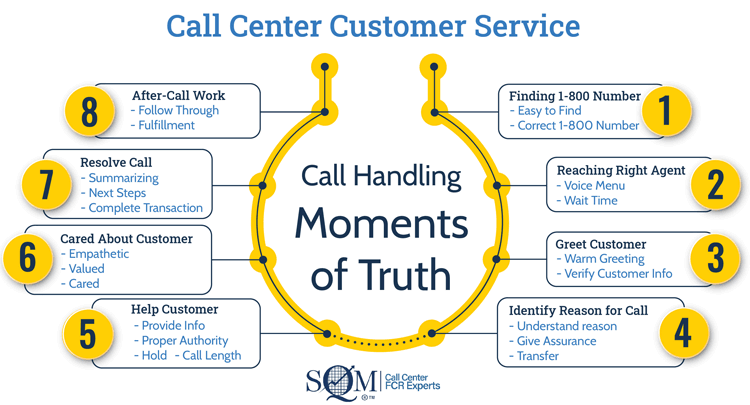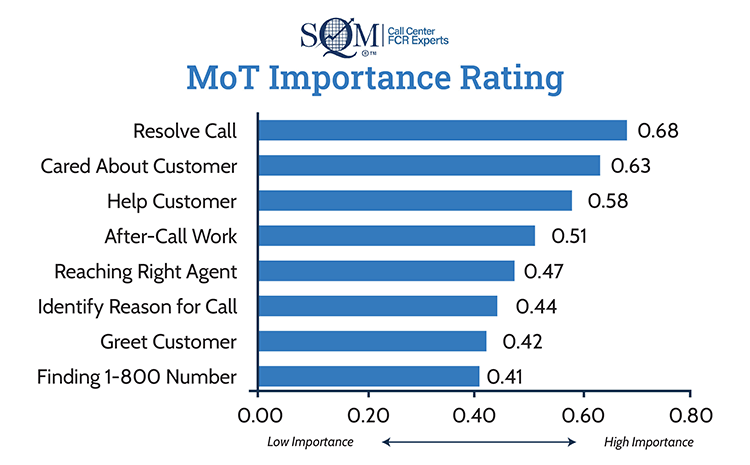Call Center Moments of Truth
The Moments of Truth (MoT) concept was developed by Jan Carlzon1 when he was CEO of Scandinavian Airlines in 1986. In his book, Moments of Truth, Jan Carlzon defines Moments of Truth as, “Anytime a customer comes into contact with any aspect of a business, however remote, is an opportunity to form an impression.”
For many customers, the call center is their primary contact channel when interacting with an organization. SQM’s research shows that 77% of customers who called a call center stated that the call center is their primary contact channel when doing business with the organization. Given the significant amount of customers that use a call center as their primary contact channel, it is essential to understand the call center’s MoT performance.
Figure 1 shows the critical MoT that a customer experiences when calling a call center. The MoT that a customer experiences when calling a call center for customer service was developed based on SQM’s extensive research and experience in benchmarking over 500 leading North American call centers. These MoT apply to all call centers and industries. Call center MoT is actual experiences a customer has when calling a call center. MoT does not include back-end operational aspects such as claim fulfillment or service work departments.
Call center customer service MoT includes:
- finding the phone number
- reaching the right agent
- a warm greeting from the agent
- the agent understanding the reason for the call
- agent helping the customer
- agent caring about customer situation
- agent resolving the call
- after-call work if necessary
Figure 1: Call center customer service MoT

MoT Customer Importance Ranking
Figure 2 shows call center customer service MoT importance ranking. The ranking is based on a derived importance statistical technique. A derived importance statistical technique is a more effective ranking method than a stated importance ranking method. This is because a stated importance ranking typically shows very little difference among MoT versus derived importance, which typically shows big differences among MoT. In other words, derived importance shows more variation, and stated importance shows less variation.
All MoT is important to customers calling a call center, and they expect the call center to deliver on all MoT when they call. ‘Resolving calls’ moment of truth is the highest in importance to a customer when calling a call center. The ‘finding 1-800 number’ moment of truth is the lowest in importance to a customer when calling a call center. When any of the MoT fail, customers can be very dissatisfied with their call center CX, higher operating costs, and, in many cases, customer defections.
The MoT importance ranking for customers when calling a call center is homogeneous. In other words, the MoT importance ranking is very similar for customers whether they are making calls in Canada, United States, or other countries. The MoT ranking similarities also hold true across all industries and call types, whether business to business (B2B) or consumer. In other words, what is important to all these different customer groups is the same or similar.
Figure 2 shows call center MoT customer importance ranking based on a statistical correlation. All MoT is important to customers; however, any MoT over 0.50 is statistically important to the customer’s experience when calling the call center. For example, the below graph shows MoT that matters the most, from a customer’s perspective, is call resolution (preferably on the first call), cared about the customer, helping the customer, and after-call work. These four MoT all have a statistical correlation of .50 or higher, and that is why they are considered the MoT that matter the most to the customers.
Figure 2: Call center customer service MoT importance ranking

Quick Related Links
First Call Resolution Definition First Call Resolution PPT First Call Resolution Benefits
First Call Resolution Strategies First Call Resolution Operating Philosophy Call Handling First Call Resolution Formula Calculate First Call Resolution What is a good FCR Rate? QA Form Customer Quality Assurance
